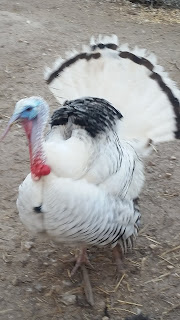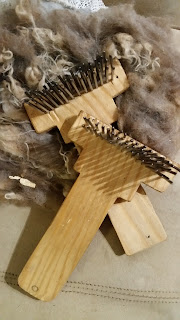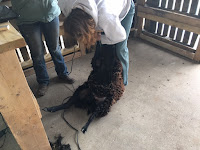
But enough of that happy, positive, things are looking up talk! We have a story wrought with sadness, frustration and life lessons to finish! Carry on.
Now where was I?
Oh yes, Neville.
 Neville was the first Royal Palm turkey on the farm, and I fell in love with him at first sight. They are a beautiful bird, bred for show not really for meat, and when in "turkey love" their faces turn a brilliant blue and their waddles apple red. Due to the popularity of the breed, I purchased 18 fertile Royal Palm eggs which I incubated with the intent of raising, breeding, and selling them. Naturally, they were in the incubator when the temperature problem happened. Out of 18 eggs, 2 hatched, one died almost immediately leaving me with one tiny bird that I rested all my hope on. If it was a female I could at least pair her with Neville and have chicks next year. Three weeks later she was killed by a visiting dog.
Neville was the first Royal Palm turkey on the farm, and I fell in love with him at first sight. They are a beautiful bird, bred for show not really for meat, and when in "turkey love" their faces turn a brilliant blue and their waddles apple red. Due to the popularity of the breed, I purchased 18 fertile Royal Palm eggs which I incubated with the intent of raising, breeding, and selling them. Naturally, they were in the incubator when the temperature problem happened. Out of 18 eggs, 2 hatched, one died almost immediately leaving me with one tiny bird that I rested all my hope on. If it was a female I could at least pair her with Neville and have chicks next year. Three weeks later she was killed by a visiting dog.After suffering yet another crushing defeat, I was determined not to give up, so an order for 6 turkey chicks was promptly placed to the nearest hatchery, and after traveling 2 1/2 hours we were once again proud turkey parents. The hatchery threw in another one for good luck, so 7 adorable little 2 day old poults began our new flock. Three weeks later a torrential rain drowned 4 of them while they huddled together in the false safety of their enclosure. Once the water subsided, the big birds were allowed out to free-range. That's when the fox got Neville.
How much can one Heeby Jeeby Mom take??!!
Obviously much, much more. One by one, the chickens began disappearing. There were no feathers on the ground indicating an eagle attack, no headless carcasses hinting at a raccoon invasion, so who was the culprit? Then, we saw it. The bushy red tail and the tall pointed ears carrying away the 10th hen of the week in broad daylight. That little bugger, along with a few of her closest friends and relatives, succeeded in thinning our flock from 40 hens, 8 roosters and 21 ducks, to 18 hens, 5 roosters and 16 ducks. Several of the birds were attacked, killed, and left under a tree. Almost like the foxes were killing for sport rather than hunger. How they achieved killing a full grown Tom turkey is still beyond my comprehension, but nonetheless it happened. Then, strangely, they were gone. Just like that.
With 22 hens no longer laying eggs, sales were drastically cut and I could no longer fill weekly orders. Three egg clients had to take their business elsewhere. Heeby Jeeby Hatchery could not offer the 9 different breeds for sale that we had advertised, and our selection of chicks for next year would be slim. Basically, we were starting over.
Things had to start looking up! Nope. Memorial weekend our precious buck, Reddick, died of congestive heart failure. He had always had a cough and had been checked for every possibly cause, but it finally took its toll on him. Red was a tri-colored mini Nubian and was exactly the right size for our farm. Not too big, sweet tempered, and would have produced small, beautiful babies that were of registered stock. Naturally, the does had already kidded and were not even close to coming into heat again, so Red never got the chance to strut his stuff. We buried him next to Cherry, our first milk goat, on the hill overlooking the farm.
Oh, speaking of hills, we had our hay cutting cancelled. Twice. Then one no-show. So now we have no hay, now way to cut it, and a field turning to straw.
OK enough of this! It's even more than I can take and I lived it. Thank God above that He also decided enough was enough and we began to see blessings emerging from the darkness.
- A farmer down the road contacted me and needed 6 hens to replace his flock. I had 6 hens without roosters that I was keeping strictly for egg production.
- A young girl contacted me wanting a black Shetland ram to breed with her white ewe. I had 2 black ram lambs for her to choose from.
- A couple messaged me needing a new rooster and 2 ducks for their flocks. Guess what? I had a rooster without hens, and 2 ducks needing a home.
- I advertised for hay equipment within budget, small enough to fit my little tractor and in 5 minutes had a phone call with exactly what I needed for a ridiculously low price.
Coincidence? More like divine intervention.
Then the biggest break of all...a friend called and asked if I had tried the huge swap meet near the caves to sell my wool products. I told her that I had never thought of selling there, but that I had wanted to visit and had never got around to it. "We sell out every year", she explained, "Including all of our goats." Ding Ding Ding. The bells went off in my head. I began frantically researching the swap meet known locally as Jacob's Cave Animal swap, and discovered that up to 50,000 visitors go through there every selling season. Hundreds of vendors sell everything from Tupperware to rifle targets, and small farm animals are the biggest draw.
Since I had already perfected setting up the farm stand for the farmers market, adding a pen to house a few small ruminants and a couple of duck carriers would be easy peasy. What I found at that swap meet was a family of vendors who spend a week selling, chatting, eating, and sharing everything they can with their neighbors. No one goes hungry. No one has a bad day. No one is a stranger. Never have I had a more enjoyable experience selling farm animals! People from near and far come to the swap, and each one is looking for something specific. The wool was a huge hit and I was able to sell it raw and unwashed to several visitors. Who knew?! Poncho became the talk of the swap after passers-by noticed him "working the sheep" through the fence. Then the newspaper showed up and did an interview, showcasing Poncho and the wool roving I had just hand-carded during an impromptu class.
Lily even had her day in the spotlight as the "How to Milk a Goat" lead star. Twice a day, shoppers would stop and gather around the milking stanchion watching as we demonstrated the finer points of goat care. Lily was only too happy to comply as long as the feed held out.
So what did all of this teach me? Life on a farm, even a little hobby farm, is not always picture perfect. Animals die, get sick, get hurt, then are born and bred to start again. Things break, fall apart, and you learn to fix them and carry on. Just when you think you "can't take no more"...you take some more. But most important of all, God is good. I learned from each of these lessons, and have a greater appreciation of all things farm related. So now...
- The incubator has been adjusted and is working fine.
- The remaining three turkeys are big and healthy, and are opposite sex so babies should be happening this year.
- I purchased a beautiful little Pygora buck (Pygmy/Angora) to add to the fiber mix and to produce fuzzy babies. At least 2 of the 3 goats are now pregnant.
- The sheep have been confined to their large run for the last three weeks, and yesterday we welcomed our 1st set of twins for the year. Without hiking up a mountain.
- I have reserved not one, but TWO swap meets; June and October. No more trying to scrape by at little markets (Though of course we will still try!).
- I pick up my new used hay equipment next month so we can cut/bale/store and sell our own.
Farming is hard. Farming is heartbreaking. Farming is wonderful and joyful and beautiful.
Farming is life.
Happy farming everyone.














































